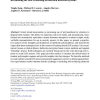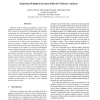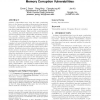29 search results - page 5 / 6 » Detection and analysis of drive-by-download attacks and mali... |
ML
2010
ACM
13 years 3 months ago
2010
ACM
Current trends demonstrate an increasing use of polymorphism by attackers to disguise their exploits. The ability for malicious code to be easily, and automatically, transformed in...
SRDS
2007
IEEE
13 years 11 months ago
2007
IEEE
Sensors that operate in an unattended, harsh or hostile environment are vulnerable to compromises because their low costs preclude the use of expensive tamper-resistant hardware. ...
EUROSYS
2008
ACM
14 years 1 months ago
2008
ACM
Eudaemon is a technique that aims to blur the borders between protected and unprotected applications, and brings together honeypot technology and end-user intrusion detection and ...
SP
2007
IEEE
13 years 11 months ago
2007
IEEE
Malicious code (or malware) is defined as software that fulfills the deliberately harmful intent of an attacker. Malware analysis is the process of determining the behavior and ...
CCS
2007
ACM
13 years 11 months ago
2007
ACM
Software vulnerabilities have been the main contributing factor to the Internet security problems such as fast spreading worms. Among these software vulnerabilities, memory corrup...



